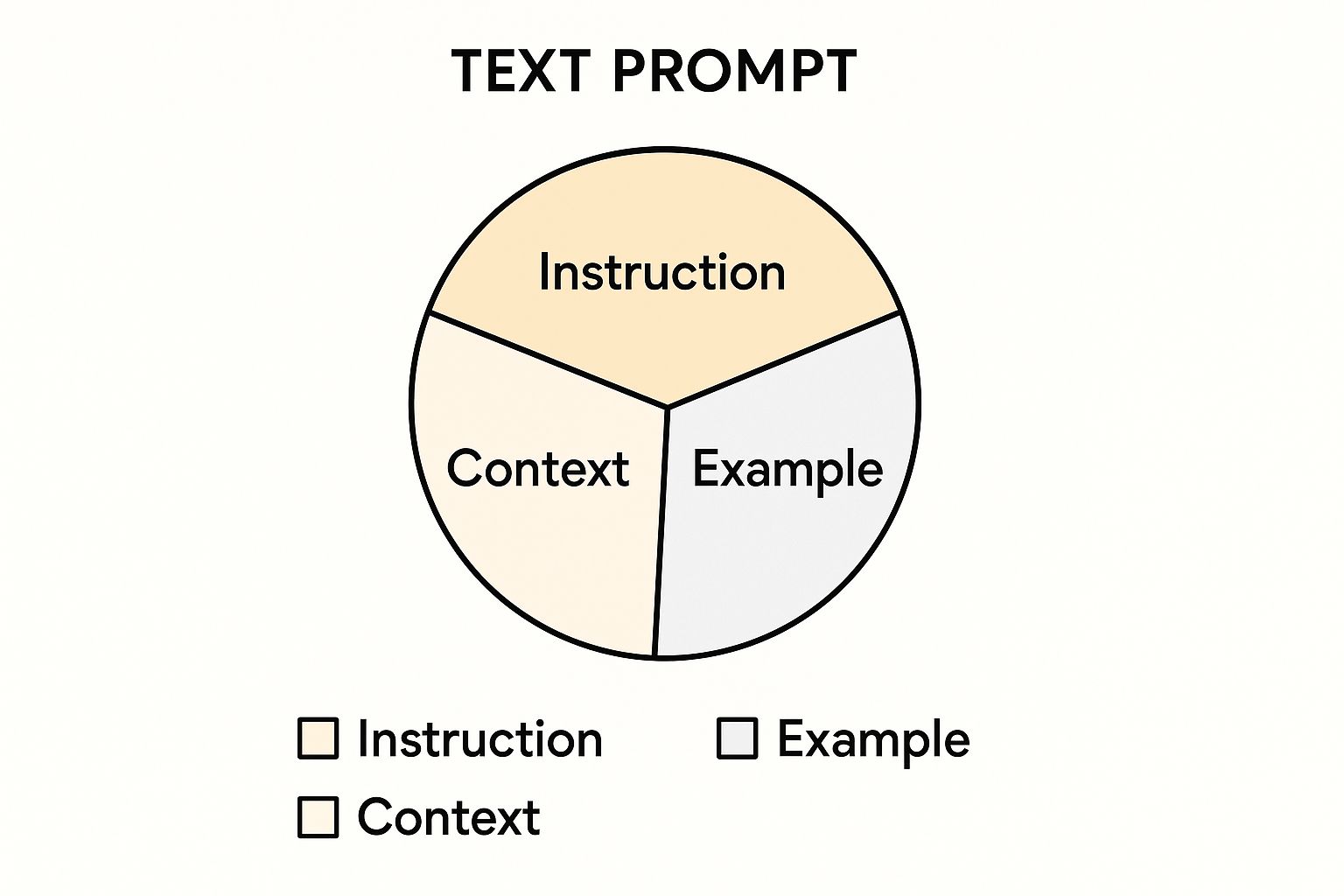The Art and Science of Effective AI Communication
Communicating with AI is a unique skill. It's less like talking to a colleague and more like learning a new language. Just as direct translations often miss the mark, so too will simply typing your usual requests into an AI system. To truly unlock its potential, you must understand the grammar and nuances of this new form of communication. Even small changes in your prompting can dramatically improve your results.
Understanding the Nuances of AI Language
Effective AI communication starts with understanding that systems like ChatGPT or Google Gemini interpret language literally. Unlike humans, they don't possess common sense or contextual understanding. This means clarity and specificity are essential. Ambiguity, easily navigated in human conversation, can completely derail your AI interactions.
For example, asking an AI to "write a blog post about dogs" offers little guidance. A much stronger prompt would be: "Write a 500-word blog post about the benefits of adopting senior dogs, targeting potential pet owners aged 30-50." This revised prompt provides crucial context (benefits of senior dog adoption, target audience) and specific instructions (length), setting the stage for a more successful outcome. As AI tools continue to develop, refining your prompting skills will become increasingly valuable.
The rising use of AI for content creation underscores the importance of well-crafted prompts. In 2023, over 85% of AI users primarily used AI for content creation and article writing. Effective prompts are well-structured, providing context and clear instructions. Honing your prompting skills will be essential for maximizing the potential of AI tools in your writing process. While tools like ChatGPT and Gemini are generally useful for content development, specialized AI tools, such as Scorecard's AI Assist, excel at data analysis. To delve deeper into these statistics, you can find more detailed information here.
Building a Foundation for Success
Mastering AI prompting isn't just about getting better outputs; it's about understanding the capabilities and limitations of AI systems. This knowledge helps dispel common misconceptions and allows you to diagnose problems. If a result is subpar, you'll be able to determine if it stems from a poorly written prompt or a limitation of the AI itself. By mastering the art of AI communication, you build a foundation for consistently exceptional results and truly unlock the power of these tools.
To illustrate the different approaches required for various AI systems, consider the following table:
To help you navigate the world of AI prompting, we've compiled a comparison of popular AI systems and their unique requirements:
Common AI Systems and Their Prompt Requirements
| AI System | Optimal Prompt Style | Strengths | Limitations |
|---|---|---|---|
| ChatGPT | Conversational, detailed, instructional | Versatile, creative writing, code generation | Can be verbose, occasional factual inaccuracies |
| Google Gemini | Concise, direct, question-oriented | Strong reasoning and summarization abilities, multimodal capabilities | May struggle with highly creative tasks, access might be limited |
| Scorecard's AI Assist | Data-focused, analytical, metric-driven | Powerful for data analysis and insights, business-oriented | Less suitable for creative writing or general content generation |
This table highlights the diverse approaches required when communicating with different AI systems. Understanding these nuances will allow you to tailor your prompts for optimal performance and leverage the unique strengths of each tool. By recognizing the specific prompt styles that each system responds to best, you can significantly enhance your AI interactions and unlock their full potential.
Anatomy of High-Performance AI Prompts
What makes a truly great AI prompt? It's all about understanding the prompt's structure. Much like a well-written sentence clearly conveys its meaning, a well-crafted prompt steers the AI toward the result you're looking for. This means providing crystal-clear instructions, rich context, and helpful examples. By doing so, you remove any guesswork and set the stage for outstanding results.
The Building Blocks of Effective Prompts
Creating effective prompts is like giving someone perfect directions. You wouldn’t simply tell someone to “go somewhere” and expect them to magically arrive at your intended destination. Similarly, vague AI prompts lead to unpredictable outputs. A strong prompt includes three vital components: instruction, context, and example. This framework ensures the AI understands not just what you want, but also how you want it and why.

This infographic shows the core parts of an effective prompt: instruction, context, and example. These elements work together to guide the AI, just like a map guides a traveler. The instruction tells the AI what to do, the context paints the background, and the example shows the desired output. This structured approach reduces misunderstandings and increases the likelihood of achieving your desired results.
Clarity, Context, and Control: The Power Trio
Clarity in your instructions is essential. Instead of requesting a "blog post about dogs," be specific. Ask for something like, "a 500-word blog post about the benefits of adopting senior dogs, for potential pet owners aged 30-50." This level of detail provides the AI with a clear path forward.
Context is equally important. It's like giving the AI the necessary background information to understand the job. For example, if you’re requesting a poem in the style of Shakespeare, provide a quick overview of Shakespearean sonnets. This ensures the AI grasps the nuances you’re aiming for, leading to more accurate and relevant results.
Finally, providing an example is like giving the AI a blueprint. If you’re looking for a specific tone or format, showing an example makes your expectations clear. Including a sample paragraph that illustrates the desired tone allows the AI to effectively match your style. Providing a desired format, such as a table or a list, also helps structure the AI's response.
To understand how to create the most effective prompts, it helps to understand the elements that contribute to success. The table below breaks down the key ingredients:
Essential Elements of Effective AI Prompts
| Element | Purpose | Example | Impact on Results |
|---|---|---|---|
| Instruction | Tells the AI what to do | "Write a short story" | Determines the overall task |
| Context | Provides background information | "Set in a futuristic city" | Adds depth and relevance |
| Example | Shows the desired format and style | "Start with a character waking up in a neon-lit apartment" | Guides the AI's output |
This table summarizes the vital role each element plays in crafting a high-performing AI prompt. By understanding these building blocks, we can unlock the true potential of AI tools.
The increasing use of AI for content creation underscores the importance of mastering prompt writing. The growth of AI in writing is evident in the rise of AI writing tools. From 2023 to 2024, the use of these tools increased by 50%, with over 70% of businesses using them in 2024. This shows the efficiency, cost savings, and SEO benefits AI brings to content creation. By 2025, AI is projected to have a significant impact on the job market. Learn more about this trend: Find more detailed statistics here. Mastering prompt writing is essential for harnessing the full power of these tools.
Crafting Prompts That Consistently Deliver Results
Unleash the true potential of AI by mastering the art of prompt engineering. Move beyond simple queries and embrace a strategic approach to prompt crafting. This will empower you to consistently extract high-quality outputs from AI, transforming your interactions from hit-or-miss to reliably insightful.
Defining Your Goals and Desired Outcomes
Before you even begin writing your prompt, take a moment to clarify your objectives. What do you hope to achieve with the AI's assistance? Are you seeking a captivating story, a concise summary, or perhaps detailed technical documentation? This clarity of purpose is paramount. It acts as your compass, guiding the AI towards your desired destination. For instance, if your goal is a compelling blog post, define the desired length, target audience, and core message. This initial planning ensures you and the AI are on the same page from the outset.
The Importance of Structure and Context
Think of your prompt as a blueprint for the AI. Just as an architect needs detailed plans, the AI thrives on structure and context. A well-crafted prompt consists of three key elements: a clear instruction, relevant context, and, ideally, an example. The instruction tells the AI what to do. The context provides the necessary background information. The example showcases the desired format or style. This structured approach minimizes ambiguity and maximizes the chances of a relevant and insightful response, bridging the gap between human intent and AI interpretation. This is especially important because AI, unlike humans, lacks inherent understanding and relies on the information provided in the prompt.
Iterative Prompting: A Cycle of Refinement
Mastering prompt engineering is not about crafting the perfect prompt on the first try. It's about embracing an iterative process, a continuous cycle of refinement. Experiment with different phrasing, add or remove details, and adjust the level of specificity. Think of it like sculpting—you start with a rough shape and gradually refine it until it matches your vision. Each iteration offers valuable feedback, allowing you to fine-tune your approach and achieve increasingly accurate and compelling results. This adaptability is key to unlocking the full potential of AI for complex tasks.
Frameworks for Different Content Formats
Tailor your prompting strategies to the specific content format you're aiming for. For a blog post, consider using a structured outline within your prompt to guide the AI's organization. For a poem, provide examples of the desired rhyme scheme or meter. These tailored frameworks act as specialized tools, equipping the AI to produce outputs that meet the unique requirements of each format. To jumpstart your prompt creation process, consider using a Prompt Generator for inspiration and structure.

Troubleshooting Unexpected Outputs
Even the most meticulously crafted prompts can sometimes yield unexpected or less-than-ideal results. Don't be discouraged. This often signifies a need for further refinement, not a failure of the AI. Perhaps the provided context was insufficient, or the instructions lacked clarity. Analyze the AI's output to identify areas for improvement and adjust your prompt accordingly. This troubleshooting process is crucial for honing your prompting skills and building a more effective dialogue with the AI. For more advanced guidance, explore these prompt engineering examples. Remember, the key to consistently achieving exceptional results with AI lies in viewing prompting as an ongoing conversation, a collaborative process of refinement and discovery.
Advanced Techniques Used by Prompt Engineering Experts
Beyond the basics of AI prompting lies a world of advanced techniques that can truly unlock its power. These strategies, used by expert prompt engineers, go beyond simple instructions and dive into the nuances of how AI behaves. This allows for clearer, more effective communication, guiding the AI toward outputs that are not only accurate but also creative, insightful, and perfectly aligned with your vision.
Role-Playing and Persona Adoption
One powerful technique is role-based prompting, where you assign a specific persona to the AI. Instead of asking for a generic blog post about marketing, you might instruct the AI to "write a blog post about marketing from the perspective of a seasoned CMO advising startups." This subtle shift can dramatically change the tone, style, and content, resulting in a much more engaging and authoritative piece. To aid in the initial creation of AI prompts, consider using a Prompt Generator for inspiration and structure.
Chain-of-Thought Prompting for Complex Reasoning
Another advanced technique is chain-of-thought prompting, which guides the AI through a logical sequence of steps. This is especially helpful for complex reasoning or problem-solving. Instead of one complex question, you break it down into smaller, more manageable sub-questions, leading the AI step-by-step. This allows the AI to tackle more intricate challenges and produce more thoughtful and insightful responses.
Fine-Tuning Output Creativity with Temperature Control
Most AI systems have a temperature setting that controls the randomness of their output. A lower temperature (e.g., 0.2) produces predictable and focused results, ideal for factual accuracy. A higher temperature (e.g., 0.8) encourages more creative and unexpected outputs, suitable for brainstorming or fiction. By adjusting the temperature, you can fine-tune the AI's creativity to fit your project's needs.

Mastering Multi-Part Prompts for Elaborate Projects
For larger projects, multi-part prompts are invaluable. These prompts break a complex task into interconnected sub-tasks, each with its own instructions and context. This allows you to manage intricate projects more effectively, ensuring AI focus and consistency. For example, when writing a long article, you could use separate prompts for the introduction, body paragraphs, conclusion, and call to action.
System vs. User Instructions: Understanding the Difference
Understanding the difference between system messages and user instructions is crucial for advanced prompt engineering. System messages give high-level guidance to the AI, setting the overall tone and context. User instructions are specific requests or commands for the current task. This separation prevents confusion and ensures the AI responds appropriately. A system message might instruct the AI to "maintain a professional tone," while a user instruction might be to "write a summary of the latest marketing trends."
Avoiding the Pitfalls That Sabotage Your AI Results
Why do some AI prompts yield disappointing results, even when they seem perfectly crafted? The problem often isn't the AI itself, but subtle issues in how we construct our prompts. This section explores common prompting pitfalls and how to transform frustration into consistently excellent AI outputs.
Cognitive Biases: How Our Thinking Shapes Our Prompts
We all carry inherent cognitive biases that unknowingly influence how we give instructions, even to AI. For instance, confirmation bias might lead us to write prompts that subtly nudge the AI towards the answers we want, rather than objective information. Anchoring bias can make us fixate on initial ideas, unintentionally limiting the AI's exploration of other possibilities. Simply being aware of these biases is a powerful first step in neutralizing their impact.
Deconstructing Failed Prompts: Uncovering Hidden Issues
Analyzing past unsuccessful prompts is one of the most effective ways to improve your prompting skills. Look for conflicting signals. Asking for a "short, comprehensive overview," for example, presents the AI with a dilemma. How can something be both brief and thorough? Identify and remove such conflicts. Similarly, be mindful of unnecessary constraints. A strict word count can stifle creativity and depth when the topic requires more space. Finally, ensure sufficient context. Giving the AI adequate background information empowers it to generate more insightful and pertinent responses. To delve deeper into prompt engineering, explore these prompt engineering examples.
Distinguishing Between AI Limitations and Prompt Problems
Learning to differentiate between inherent limitations of the current AI technology and flaws in your prompt is essential. If the AI consistently fabricates facts or struggles with basic logic, that might be a technological hurdle. However, if the output is irrelevant or doesn't meet your specified style, the problem likely lies within your prompt. This discernment saves you time and energy, allowing you to focus on refining your prompting technique rather than battling the current limitations of AI.
Building a Prompt Evaluation Checklist: A Proactive Strategy
Develop a checklist to review before submitting any important prompt. This proactive approach maximizes your chances of success. Consider these key areas:
- Clarity: Is the instruction clear, concise, and easily understood?
- Context: Have you provided enough background for the AI to grasp the nuances of your request?
- Constraints: Are there any limitations (word count, format, etc.) that could be hindering the AI?
- Consistency: Does the prompt maintain a consistent tone and style throughout?
- Expectations: Are your desired output format and length clearly stated?
By systematically evaluating your prompts, you preemptively address potential issues and dramatically improve the quality of your AI interactions. This thoughtful preparation paves the way for effective and efficient use of AI's potential.
Tailoring Your Approach For Different Industries
While the core principles of crafting effective AI prompts hold true across the board, different industries benefit from a more specialized approach. Just as you wouldn't address a physicist the same way you would a fashion designer, your AI prompts need to reflect the distinct language, objectives, and nuances of each sector. This ensures the AI grasps your intent and generates relevant, appropriate, and impactful results.
Adapting To Industry-Specific Language And Knowledge
Every industry possesses its own terminology and specialized knowledge. Weaving relevant terms into your prompts ensures the AI understands the context and delivers outputs aligned with industry standards. For instance, simply asking an AI to "write about project management" yields broad, generic results. A more effective prompt for the software development industry might be: "Write a blog post about using Agile methodologies to manage a software development project." This demonstrates a command of industry-specific terms like "Agile" and "Scrum" and provides clearer direction.
Navigating Regulatory and Compliance Requirements
Highly regulated industries, such as healthcare and finance, demand extra attention. Your prompts must consider relevant regulations and compliance standards. For example, when generating content for the financial industry, prompts should emphasize compliance with regulations like GDPR and avoid offering specific financial advice. This ensures the generated content is both informative and legally sound.
Examples of Industry-Specific Prompting
Let's illustrate how prompts can be adapted for various industries:
- Marketing: "Draft compelling ad copy for a new line of sustainable athletic wear, targeting Gen Z consumers interested in fitness and environmental responsibility."
- Healthcare: "Summarize recent research on mental health support for teenagers, focusing on non-pharmacological interventions and avoiding medical recommendations."
- Education: "Develop an engaging lesson plan for a middle school science class on renewable energy sources, incorporating hands-on experiments and discussion questions."
- Technical Writing: "Create clear and concise documentation for a new API, explaining its functionality, parameters, and error handling."
- Creative Industries: "Write a short screenplay in the style of Quentin Tarantino, incorporating themes of revenge and dark humor."
These examples highlight how incorporating industry-specific language, insights, and requirements leads to more impactful and relevant AI-generated content.
Best Practices For Tailored Prompting
Here are some best practices to ensure your AI prompts are effectively tailored:
- Research Industry Vocabulary: Immerse yourself in the specific language of your target industry.
- Grasp Regulatory Landscape: Be mindful of any legal or ethical guidelines pertaining to your industry.
- Set Clear Context: Provide the AI with sufficient background information to understand the nuances of your request.
- Illustrate With Examples: Show the AI the desired style and format of the output.
- Refine Through Iteration: Continuously test and refine your prompts to achieve optimal results.
By following these best practices, you can harness the power of AI to create targeted, compliant, and high-quality content across any industry. Remember, AI is a powerful tool, and like any tool, its effectiveness hinges on how skillfully you wield it. By adapting your prompting strategy to your specific needs and the nuances of your target audience, you unlock AI's full potential.
Measuring Success and Refining Your Prompting Strategy
Moving beyond simply crafting AI prompts, let's explore how to gauge their effectiveness and refine your approach. This involves transitioning from an artistic approach to a more scientific, data-driven strategy, systematically evaluating prompts and monitoring progress. This allows you to not only grasp what works but also understand why, transforming prompt creation into a repeatable process.
Establishing Clear Quality Criteria
Just as a seasoned chef tastes their creations throughout the cooking process, you must continually assess the output of your AI prompts. But how do you define "good" output? Establishing clear quality criteria is the first step. This might involve metrics like:
- Accuracy: Is the information factually correct and free of errors?
- Relevance: Does the output directly address the prompt's request and remain focused?
- Clarity: Is the writing clear, concise, and easily understood?
- Creativity (if applicable): Does the output exhibit originality and imaginative thinking?
- Tone and Style: Does the writing reflect the desired voice and tone?
By defining your ideal outcome, you establish a benchmark against which to measure every AI-generated piece. This empowers you to move beyond subjective impressions and rely on tangible data, making prompt writing a more structured process.
Building Your Personal Prompt Library and Templates
Maintaining a personal library of successful prompts is akin to possessing a cherished recipe book for AI interaction. Each time a prompt yields exceptional results, save it! Categorize these prompts by content type (blog posts, poems, code, etc.) or by desired outcome. This creates an invaluable resource for future endeavors, allowing you to build upon past achievements.
Further enhance your workflow by developing templates for common tasks. For example, craft a template for "how-to" blog posts or for generating social media captions. These templates provide a reliable framework, enabling quick adaptation to specific requirements and significantly reducing prompt creation time. This forms the foundation of efficient AI interaction, making prompt design scalable and efficient.
A/B Testing: Optimizing Prompts for Peak Performance
A/B testing, a common marketing technique, proves equally valuable for prompt engineering. Create two slightly different versions of a prompt and compare the AI's responses. One version might use more precise instructions, while another employs a different tone. Analyzing the results provides insights into the subtleties of AI communication. This data-driven method helps cultivate an intuitive understanding of how minor adjustments can profoundly impact the final output, transforming prompt writing from guesswork to informed decision-making.
Managing Prompt Iteration and Documentation
For complex projects, managing prompt iterations is essential. Implement a system for tracking different prompt versions and their corresponding AI outputs. This could involve a simple spreadsheet or a dedicated project management tool. Meticulous documentation provides a clear record of your progress, allowing easy reversion to previous versions if necessary. This proves especially valuable for intricate projects where clarity and structure are paramount.
Finally, document the patterns you observe. Note which prompt types consistently yield positive results for specific objectives. This creates a knowledge base for future reference, transforming your AI interactions into a continuously improving process. By learning from past successes (and setbacks), you refine your prompting strategy, ensuring that your AI communication becomes increasingly effective over time.
Ready to streamline your content creation process and unlock the true potential of AI? Explore how Henri Den can seamlessly integrate AI into your workflow and help you achieve your business goals. Visit Henri Den today to learn more.





